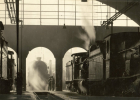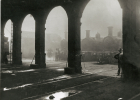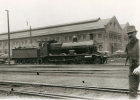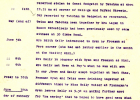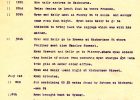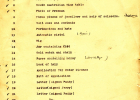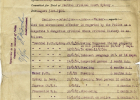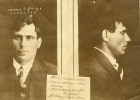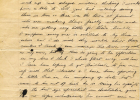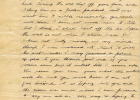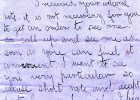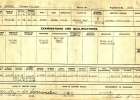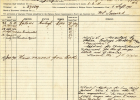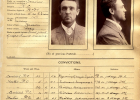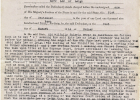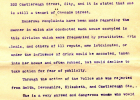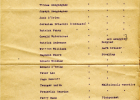The scene of the crime
It was the morning of 10 June 1914, payday at the Eveleigh Railway Workshops on Wilson Street, Sydney. Paymaster for the NSW Railways, Frederick Charles Miller, along with his junior, John Henry, drew up at the factory complex in a horse-drawn wagon. Albert Andrews was driving the wagon that day, as he had on many occasions. They were returning from the bank with two cash boxes on the tray: one containing £3696; the other £3302.
Miller reported that two men met the cab as usual; one of whom was Norman Twiss. Twiss had been working at Eveleigh for over 18 months. One box was taken into the main office so the money could be distributed to the workers. Then they returned to the wagon where Twiss began to pick up the second chest off the tray.
The heist and the getaway car
All of a sudden an old drab-grey car sped up and skidded to a halt in the gravel beside the wagon. It was driven by Ernest Alexander Ryan (aka Shiner), with Samuel Freeman (aka Jewey) in the passenger seat; both men were wearing handkerchief masks and driving goggles. According to Andrews, a man (later identified as Freeman) jumped out of the car singing ‘Bail up!’ and pointed a revolver at Miller’s head. He shoved Miller to the ground and ordered Twiss to hand over the cash chest. According to Miller’s statement, Twiss lowered the box so Freeman could ‘conveniently’ take it.
Robert Hodge, one of the men who met the cab on its arrival at the workshop, made an attempt to go towards the cashbox and admitted in his statement that he:
could give a fair account of myself in a tussle but the man in the motor car pointed a revolver at me and said ‘Don’t’.
Freeman loaded the chest into the back of the car, leapt in and was driven away by Ryan. In a brave attempt, Albert Andrews (the cab driver) went after the getaway car but unfortunately his horse was ‘not very fast. I was not able to overtake the car.’ The Sydney Morning Herald reported the following day that the car ‘progressed city wards, and with great speed.’
An eyewitness and suspicions aroused
Meanwhile, a bystander had taken down the licence number of the getaway car – 10297. The police traced it to a mechanic named Arthur Tatham, who had reported the car stolen from Castlereagh Street, Sydney the day before. Detectives were sure Tatham knew more than what he had told them.
As the police searched for the money, the car and the thieves, Miller came to them with his suspicions about Twiss. To Miller, Twiss had seemed unusually cool when under the gun. An informer whispered to the Police that Freeman was the ringleader.
Robbery under arms – £400 reward
The 1914 Police Gazette reports:
A reward of four hundred pounds will be paid by the Government for such information as shall lead to the apprehension and conviction of the two masked and armed offenders, who absconded in a motor car.
Arrest of the Gang
The thieves plan was to escape to Melbourne and leave for the United States from there. So while they waited it out in Sydney you might think they would follow the old gangster advice of laying low. Shiner Ryan did just the opposite.
Shiner Ryan
Shiner Ryan went on a date with girlfriend Ettie Kelly the night before the robbery and he told her he hoped to have good news the following day. He saw Ettie after the robbery and gave her some money. Ettie noticed he was wearing a diamond ring and on emptying his pockets he had more money and a revolver.
Ryan took Ettie to the jeweller’s where he bought her two bangles and a diamond cluster ring. For himself, he bought a gold watch and a gold locket set with diamonds and rubies. Then came the new wardrobe, bottles of champagne, expensive dinners and upstairs tickets for the Theatre Royal. Ryan knew how to have a good time!
Ryan sent his share of the stolen payroll money by train to his friend, Sam Faulkiner, a Melbourne bad-hat. Ryan then disguised himself and managed to jump on a train to Melbourne to retrieve the cash. In a later police statement, he cheekily states how he managed to get on the train when the station was crawling with police:
I can tell you it is no reflection on your men that they did not catch me, your men had no chance.
Unfortunately for Ryan, when he arrived in Melbourne he discovered that Faulkiner had absconded to Tasmania with the cash. In early July, Ryan was arrested in Melbourne. Officers found £600 in a glass jar hidden in the chimney. This was the only money ever recovered from the Eveleigh robbery.
Jewey Freeman
On 24 June, Samuel Freeman (Jewey) was arrested at Strathfield Station as he was boarding a Melbourne Express. Freeman stated that on the day of the robbery he had been at the Races. He was charged with armed robbery and assault.
Twiss, the Inside Man
As the Police investigated the robbery they attempted to link Freeman, Ryan, Twiss and Tatham together. When questioned, Twiss admitted he had known Freeman previously, but denied being an accomplice. In his statement to the Police he was adamant:
I wish to state that I know absolutely nothing at all about this robbery.
A railway labourer, Francis Joseph Gilbert, came forward with information. Gilbert had known Twiss from ten years ago when they were both in Dubbo and he told the Police that about 5 weeks before the robbery, Twiss mentioned in a conversation that ‘it would be very easy for anyone to get at the money’.
Molly Butler, barmaid at Flanagan’s Hotel in Oxford Street also told the Police that she had seen Jewey (Freeman), Norman (Twiss) and Paddy together at different times before the robbery. On the same day as the robbery Twiss and Tatham were seen together at the pub, although Twiss denied this later.
Twiss was arrested on 11 June and Tatham, owner of the ‘stolen’ getaway car was also charged.
The Court case
In September 1914 at the Central Criminal Court in Darlinghurst, Freeman, Ryan, Twiss, and Tatham pleaded not guilty to assaulting Fred Miller and stealing £3302. Freeman also faced charges of shooting and wounding Michael McHale, a nightwatchman who had routed him trying to rob the Paddington Post Office in Oxford Street just four days before the Eveleigh job. See the list of exhibits.
Twiss was acquitted because of a lack of concrete evidence against him. Elated he kissed Ryan in the courtroom and waved goodbye.
Larry Writer in his book Razor states that once on the witness stand, Shiner Ryan lied outrageously. He portrayed himself as a struggling inventor who had only come to Sydney to find buyers for his invention. Ryan stated he had nothing to do with the robbery. Ryan was found guilty and sentenced to ten years at Parramatta Gaol. In his first few days in prison he tried to slash his wrist and ankle with a sharp metal object but he did not succeed and served the rest of his sentence quietly. He wrote to Ettie from prison.
The Kate Leigh connection
Samuel (Jewey) Freeman was also on trial for shooting Michael McHale, a night watchman at the Post Office on Oxford Street, with intent to murder on 6 June 1914 (four days before the robbery). Jewey’s girlfriend, a young Kate Leigh, decided to provide Freeman with an alibi, stating they were together on the night of the 5th June at the Exhibition Skating Rink and then at her house in Cascade Street until late in the afternoon the next day. There were many problems with her alibi though:
- Ettie Kelly and May Bragg contradicted Kate by stating they were with Freeman on the night of 5 June
- The skating rink had closed at the time when Kate states she was there with Freeman
- Freeman was seen by two witnesses, McHale and Jackson, between 6-7am in Oxford Street on 6 June (the time of the offence).
- Detective Robertson and Constable Hooper stated that Kate admitted she did not know Freeman when she visited him in gaol after his arrest at Strathfield Station.
Not helping her case is the statement of Raymond Moore. Kate tried to coerce Moore, who was residing at a house occupied by Kate, to state he had seen Freeman there from 11pm for an all night party. Kate claimed that Freeman remained at her place on the couch until 6pm the following day (6 June). In an attempt to persuade Raymond to collaborate her story
she went into the yard and got a tommyhawk and came in and said I will cut your bloody head off, you bastard, and chopped me on the right eye with the point of the tommyhawk. I put up my left hand over my face and she hit my left arm breaking it in two places.
The Jury did not believe Leigh and Freeman, like Ryan, was sentenced to 10 years in Parramatta Gaol.
Kate Leigh was arrested for perjury and during her trial in March 1915, Senior Constable Charlton, reported that eight years earlier numerous complaints were made against Leigh by her neighbours:
Each house was frequented by prostitutes, criminals, and others of ill repute, men intoxicated, or under the influence of drink would be accosted taken into her house and often robbed, but would decline to take action for fear of publicity. She is a very shrewd and dangerous woman who would resort to any device for revenge, and has often got satisfaction by so doing. [9/7196]
When coming to sentence Kate Leigh the judge threw the book at her and she was sentenced to 5 years at Long Bay Gaol.
The heist that shocked the Nation
The Eveleigh Heist has gone down in history as “the heist that shocked the Nation”. It was a sensation in 1914 due to its daring manner: it was committed in broad daylight in a densely populated part of the city; revolvers were used and; for the first time in Australia, a car was involved in the execution of a robbery.
The Herald of 11 June described it as
the most sensational exploit of the criminal fraternity. The Eveleigh holdup is surely unique of its kind in the history of Australia
and the article continues with ‘The most striking feature of the whole episode is the careful manner in which it was planned’. The thinly veiled admiration of the culprits was clear.
Joseph Clifford, who at the time of the robbery was ‘sitting in the sun reading the paper’ was a witness at the trial. During the court case he was taken outside to look at a motor car and identified the car as being like the one he saw on the day of the robbery; he did not know the make of the car.
Walter Childs, Superintendent of Police, found the motor car No. 10297 in Bulwarra Lane. According to Childs it was a Moleyn car. In the car was the empty cash box, and a revolver.
Romantic ending
Shiner Ryan spent most of his life in and out of prison. In 1946 he began corresponding by mail with Kate Leigh. He had lived with Freeman and Leigh in Frog Hollow, Sydney leading up to the Eveleigh Heist. An unlikely romance blossomed and the pair were engaged in January 1947 but had to wait until Ryan was released from gaol to marry in Fremantle in 1950. The marriage did not last more that a few months though and the pair continued to live on opposite sides of the country until Ryan’s death in 1954.
List of records used
NRS 880 Supreme Court Papers and Depositions, Supreme Court Sydney and on Circuit [9/7189] R V Samuel Freeman and Others
NRS 880 Supreme Court Papers and Depositions, Supreme Court Sydney and on Circuit [9/7196] R V Kate Leigh, Perjury
NRS 2397 Photograph description books/ sheets Parramatta Gaol [3/6011] no961 Norman Twiss
NRS 2467 Photographic Description Books State Penitentiary, Long Bay [3/6087] no 13875 Ernest Alexander Ryan
NRS 2467 Photographic Description Books State Penitentiary, Long Bay, Samuel Freeman no. 13845 [3/6086] Reel 5117
NRS 2496, State Reformatory for Women, Long Bay Photographic Description Book, Kate Leigh No 188, [3/6007]
NRS 10958 Police Gazette 1914 [1/3249] pp. 281-282 Reel 3598
Other sources
Larry Writer, Razor: a true story of slashers, gangsters, prostitutes and sly grog, Macmillan, 2001.
Research by
Rachel Hollis, Archivist Public Access
